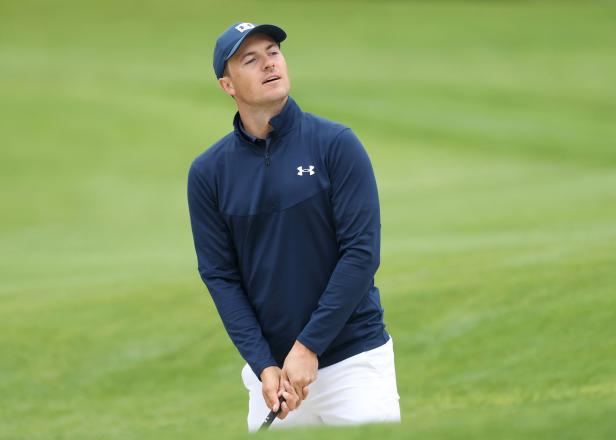Imagine trying to explain 2020 to your former self from, say, 2014. “Things got really weird,” you’d say, and your former self would have to ask, “How?” And when you began to explain the inexplicable, your former self would think this was some kind of prank, get angry and start an argument. And there you would be, fighting with yourself that could affect your past and future in unknown, untold ways.
Was that a weird first paragraph? No weirder, I would argue, than 2020 itself. And if we’re going to do a retrospective on interesting statistics from the year, we need to make room for the really bizarre stuff that you’d never notice unless you looked. (Besides, we’ve already done it the other way.) With that in mind, here are the 10 most head-scratching, brain-melting, downright odd numbers from the year that can’t end fast enough.
Jordan Spieth and the Reverse Bounce Back
The PGA Tour keeps a stat called Reverse Bounce Back, which measures how often a player makes a birdie or better on a hole followed by a bogey or worse on the next hole. Basically, it shows who’s best at not sustaining success. In the 2019-’20 season, Jordan Spieth managed to make a under-par score on 235 holes. That’s more than players like Dustin Johnson and Webb Simpson, who had brilliant seasons. The problem for Spieth is that he followed up with an over-par score on the next hole 48 times, making him 183rd out of 193 players. He’s also one of just 14 players with a rate worse than 20 percent. Clearly, this is the kind of thing that sabotages a good round, and the stat probably does more to give insight to the strange nature of Spieth’s struggles than any other.
Rob Oppenheim, secret final-round assassin?
Another interesting and under-publicized stat the tour keeps is called, simply, Final Round Performance. This measures the percentage of time a player either improves his position over the final round or stays the same. As it turns out, the champ in this stat for the 2019-’20 season was Rob Oppenheim. Now, this is more than a little strange, since Oppenheim’s season was pretty humble—138th on the FedEx Cup list, no wins, only one top-10 finish (Puerto Rico). But as it happens, he improved his position 90.91 percent of the time during a final round (10 of 11), just beating out Jason Day. Sadly for Oppenheim, it looks like the only exception came at the Wyndham Championship, where he followed up a Saturday 62 with a Sunday 72, missing his best chance at his first career PGA Tour title.
Rickie Fowler, Patrick Reed and Rory McIlroy love the smell of par 3s in the morning
Here’s an amazing one: Early Par 3 Scoring Average. This is a stat that shows how good you were on par 3s when you teed off in the morning wave. What does this mean? What does it signify? Why does it exist? I have no clue, but I’m glad it does, because now I know that Rickie Fowler was the best player on the PGA Tour in that very arcane category in the 2019-’20 season with a 2.87 average. And thus far in the 2020-’21 season, Patrick Reed leads the way with a 2.72 mark, followed by Rory McIlroy at 2.74. And now you know these things, too, and you’ll probably remember them more clearly than your own cousin’s name in five years.
Dustin Johnson, morning hater
I’m sorry, but now that I know they exist, I can’t stop looking at these early/late splits. Two of the most interesting are Early Scoring Average (i.e., your average when you teed off in the morning wave) and late scoring average (teed off in the late wave). By themselves, they’re kind of a shoulder shrug, but taken together they’re fascinating, because you can see where the biggest disparities lie. And the most jaw-dropping one belongs to … wait for it … Rickie Fowler. He was second in early scoring average during the 2019-’20 season (68.05 over 21 rounds), and 186th in late (sn average of 72 from 23 rounds). That’s a big deal! It’s even more fun to look in the other direction—night owls who hate the morning. Dustin Johnson (second vs. 78th), Bronson Burgoon (eighth vs. T-119th), and Billy Horschel (11th vs. T-135th) are the biggest loathers of sunrise here.
Long Paul Casey, master of the Hawaiian Leviathan Hole
In 2020 on the PGA Tour there was one hole that was longer than 650 yards: the 18th hole at the Sentry Tournament of Champions. Despite the rarity, it still merits its own statistical page, and I’m happy to report that Paul Casey is the only player who birdied it all four days. And he did it without reaching the green twice every time!
Lefty hates the left rough
Hey, if we’re going to break things down by early and late tee times, why not by sides of the hole? The tour offers stats on birdie percentage from the right and left rough, and it turns out that one of the notable disparities belongs to Phil Mickelson, who ranked T-6 from the right rough (15 of 66) and 121st from the left (15 of 109). Very off-brand for the man they call “Lefty,” though, to be fair, this does mean he’s better when hitting his approaches to the left.
Mark Hubbard had the longest streak of one-putts—22 straight holes during the third and fourth rounds of the Zozo Championship—of any player on the PGA Tour in 2020. Exactly how meaningful the stat is, well, we’ll let you judge for yourself. Hubbard shot a 71 and 69 in the two rounds and finished T-41 in the tournament. The streak would feel a little more “special” if he had holed a real monster putt or two, but interestingly enough the longest of any he made during that stretch at Sherwood Country Club was 19 feet, 3 inches, which was one of only three that were longer than 10 feet during the streak. And yet the streak is pretty remarkable when you consider the next longest in the calendar year came from Wyndham Clark with 13 straight holes at the RBC Heritage in July.
Jim Herman and his “old school” length
You want to know which player hits his drives less than 240 yards more than anyone else? It’s Jim Herman, the only player to fall under what I’m now calling “The Herman Line” more than 10 percent of the time in the 2019-’20 season (77 out of 732 drives). This is, of course, a dubious distinction—the 43-year-old has only done it eight times in 206 drives so far in the 2020-’21 season—but in some ways doesn’t it make you respect the fact that he actually won an event in Greensboro? This is like an NBA team winning a championship without being allowed to shoot three-pointers, or a baseball team capturing the World Series with no home runs. Take heart, all who are intimidated by Bryson: It can be done!
The best ball-striker is … Corey Conners?
Combine total driving and greens in regulation and you have a stat called ball striking. It’s an attempt to measure tee-to-green performance, and remarkably, Corey Conners topped the list in the 2019-’20 season over guys like Paul Casey, Jon Rahm and Dustin Johnson. Seeing this, and knowing that he only finished 53rd on the FedEx Cup points list at the end of the 2019-’20 season, with only one top-10 finish, you might think, “hmmm, he must struggle on the greens.” And hoo boy, you would be right: Conners was 181st in strokes gained/putting, more than enough to nullify his strength before he gets to the putting surface. He’s the anti-Denny McCarthy (see No. 10 here). If only they could combine forces!
Ryan Armour and Hank Lebioda: The SMASH Brothers
I’m telling you, these stats pages are an absolute treasure trove. Smash Factor, which is one of the radar stats (numbers that literally require radar to be calculated), is described as follows: “Ratio of Ball speed to Club head speed (Ball speed / Club speed) on par 4 and par 5 tee shots where a valid radar measurement was taken.” You had me at the word “smash,” but that’s cool, too. Here, you might expect to see Bryson and Cam Smith and Rory and the other massive hitters, but guess what? The biggest “smashers” in the 2019-’20 season were Ryan Armour and Hank Lebioda. That means they generate the most power relative to the least amount of swing speed, and to me, that’s a pretty cool thing. I don’t know if it means they maximize their body motion or hit the ball the most cleanly or what, but it’s no surprise to see Jordan Spieth tied for third, or people like Robert Streb, Patrick Cantlay, and Webb Simpson in the top 20. These are guys who maximize their physical gifts and get the most out of their swing. Now, imagine what they could do if they beefed up to Bryson proportions … a 300-pound Spieth might be the first man to routinely drive the par 5s.


